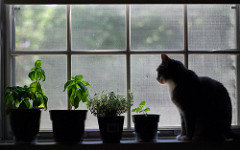Back to December 2016 Newsletter
How to Grow Winter Vegetables Indoors

Bob Wildfong
My house is a comfortable place in the winter. There's a warm wood stove, a nice bright window, and lots of blankets and sweaters. My houseplants, however, don't seem to feel the same way. They stretch for more light, or they don't grow at all, which doesn't make for good indoor vegetable gardening. Let's think about it from the plant's point of view.
The main difference is the amount of light. Plants are literally solar-powered: they create their own food by gathering light. The energy that it takes to grow leaves, roots, flowers, and other plant parts is easily available from the summer sun, but your best sunny window probably only has 10% of that energy available in the winter.
A sunny window looks really bright, especially with white snow reflecting, but our eyes can adjust to light so well that we can't tell how dim it really is. Think about what it's like when you step indoors on a bright summer day. For a brief moment, you can hardly see anything until your eyes adjust, but then the indoors becomes brighter. That's your eyes playing tricks, and for the same reason, you can't notice that the sun is a lot less intense in the winter. But solar-powered plants can tell. Put that together with the fact that the sun shines only 1/2 to 3/4 as long each day, and you can understand how your plants would feel hungry.
Most plants go into a natural dormancy during winter, because of the lower light. With less energy, they simply can't grow, so they hibernate instead. Your job as a winter vegetable gardener is to wake those plants up and make them grow normally, by giving them lots more light than the sun does.
One way to do that is to provide extra light. It doesn't have to be a special grow-light: any ordinary lamp will help. The best time is in the early or late parts of the day, when the sun is lowest or not shining at all.
Another strategy, which works very well, is to grow plants that need less energy. Since plants are solar-powered, and different plant parts take more or less energy to grow, you will have the greatest success with plants that have low-energy anatomy. Leaves, for example, take a lot less energy to create than flowers and fruit do. That's why an indoor tomato or pepper plant might grow green leaves but never give you anything to eat. Instead, try lettuce, spinach, baby greens, or sprouts.
Root vegetables can also be successful with reduced winter sunlight, though you have to provide a big enough container for them. Instead of long carrots or giant beetroots, try mini or half-long carrots, baby beets, or radishes. The depth of the soil is an important factor for roots, so look for containers that are deep, even if they're narrow.
Some vegetables like heat; for instance tropical crops such as tomatoes and peppers. Keep those away from drafts and cold glass, because any chill can cause them to go into hibernation and stop growing. Instead, put cool-weather plants near windows. Those include many greens such as lettuce and spinach, roots such as carrots, beets, and radishes, as well as peas (which grow nicely in a large container if you give them something to climb on). If in doubt, look for any seeds that "can be sown as soon as the soil can be worked" in early spring. They don't mind chilly nights outdoors, so they won't mind a chilly windowsill either.
You might find that your winter plants need frequent watering if the air is especially dry indoors. On the other hand, the soil might dry out slower if the sunlight is not intense. Either way, wait until the surface of the soil becomes dry, then water normally. Overwatering is generally worse than underwatering, so let the soil surface tell you when to re-water.
Finally, a hint on herbs. All herbs in the mint family (including basil, oregano, rosemary, marjoram, and sage) create their flavour in oils on the leaves. Like all oils, they need a lot of energy to create that flavour, so you will find these herbs to be fairly bland during winter unless you give them a lot of supplementary light. Herbs from the onion and carrot family (including chives, dill, parsley, and cilantro) create their flavour in the juices of the leaves, which take less energy. You will find these to be reasonably flavourful, even in reduced light.
Every windowsill is a different growing environment, even more so than the difference from garden to garden, so it is impossible to predict your results before you experiment. Give your plants extra light, keep them warm if they're tropical, and start with leafy greens and carrot-family herbs if you want to start with success.
Hope you enjoy your winter garden!
**
Bob Wildfong is Seeds of Diversity's executive director.
Photo: Things I'm growing in my apartment. Rachel James. CC BY-NA-SA 2.0 via Flickr.
Not yet a member?
An annual membership to Seeds of Diversity gives you access to our seed exchange, seed grow-out programs, and our online news.

We depend on donations to do our work.

Thank you for your support!
